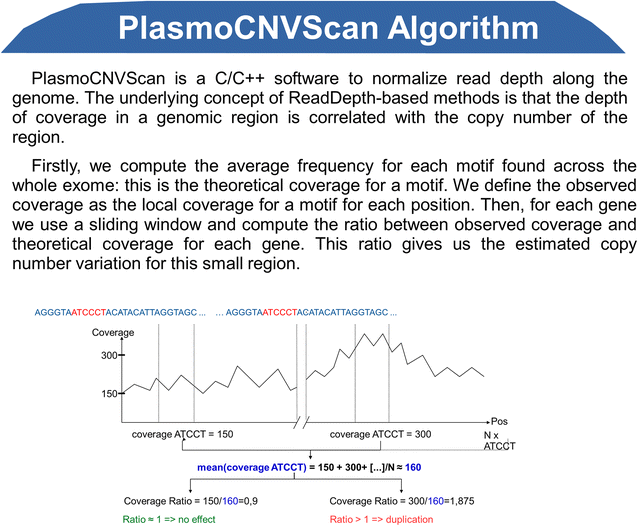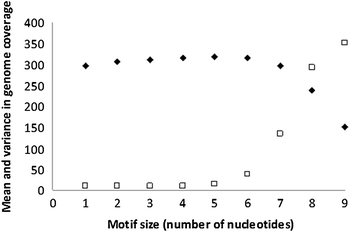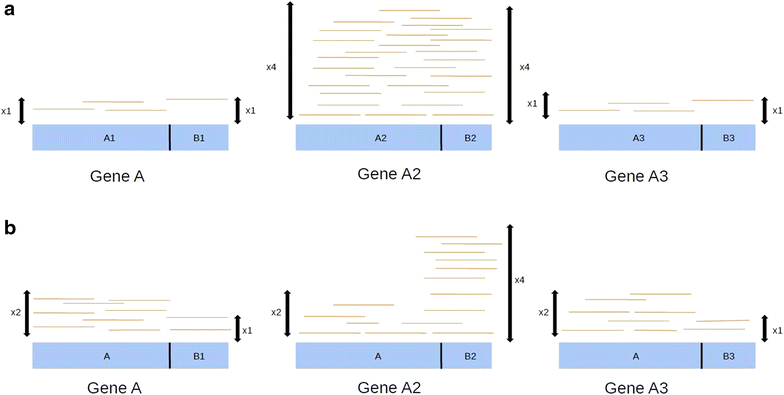Plasmodium copy number variation scan: gene copy numbers evaluation in haploid genomes
- PMID: 27066902
- PMCID: PMC4828863
- DOI: 10.1186/s12936-016-1258-x
Plasmodium copy number variation scan: gene copy numbers evaluation in haploid genomes
Abstract
Background: In eukaryotic genomes, deletion or amplification rates have been estimated to be a thousand more frequent than single nucleotide variation. In Plasmodium falciparum, relatively few transcription factors have been identified, and the regulation of transcription is seemingly largely influenced by gene amplification events. Thus copy number variation (CNV) is a major mechanism enabling parasite genomes to adapt to new environmental changes.
Methods: Currently, the detection of CNVs is based on quantitative PCR (qPCR), which is significantly limited by the relatively small number of genes that can be analysed at any one time. Technological advances that facilitate whole-genome sequencing, such as next generation sequencing (NGS) enable deeper analyses of the genomic variation to be performed. Because the characteristics of Plasmodium CNVs need special consideration in algorithms and strategies for which classical CNV detection programs are not suited a dedicated algorithm to detect CNVs across the entire exome of P. falciparum was developed. This algorithm is based on a custom read depth strategy through NGS data and called PlasmoCNVScan.
Results: The analysis of CNV identification on three genes known to have different levels of amplification and which are located either in the nuclear, apicoplast or mitochondrial genomes is presented. The results are correlated with the qPCR experiments, usually used for identification of locus specific amplification/deletion.
Conclusions: This tool will facilitate the study of P. falciparum genomic adaptation in response to ecological changes: drug pressure, decreased transmission, reduction of the parasite population size (transition to pre-elimination endemic area).
Keywords: Anti-malarial drug resistance; Bioinformatics; Copy number variation; Malaria.
Figures




Similar articles
-
Noise cancellation using total variation for copy number variation detection.BMC Bioinformatics. 2018 Oct 22;19(Suppl 11):361. doi: 10.1186/s12859-018-2332-x. BMC Bioinformatics. 2018. PMID: 30343665 Free PMC article.
-
CNV-RF Is a Random Forest-Based Copy Number Variation Detection Method Using Next-Generation Sequencing.J Mol Diagn. 2016 Nov;18(6):872-881. doi: 10.1016/j.jmoldx.2016.07.001. Epub 2016 Sep 3. J Mol Diagn. 2016. PMID: 27597741
-
Population Structure Shapes Copy Number Variation in Malaria Parasites.Mol Biol Evol. 2016 Mar;33(3):603-20. doi: 10.1093/molbev/msv282. Epub 2015 Nov 26. Mol Biol Evol. 2016. PMID: 26613787 Free PMC article.
-
Exome sequence read depth methods for identifying copy number changes.Brief Bioinform. 2015 May;16(3):380-92. doi: 10.1093/bib/bbu027. Epub 2014 Aug 28. Brief Bioinform. 2015. PMID: 25169955 Review.
-
Exome sequencing and whole genome sequencing for the detection of copy number variation.Expert Rev Mol Diagn. 2015;15(8):1023-32. doi: 10.1586/14737159.2015.1053467. Epub 2015 Jun 18. Expert Rev Mol Diagn. 2015. PMID: 26088785 Review.
Cited by
-
5WBF: a low-cost and straightforward whole blood filtration method suitable for whole-genome sequencing of Plasmodium falciparum clinical isolates.Malar J. 2022 Feb 16;21(1):51. doi: 10.1186/s12936-022-04073-1. Malar J. 2022. PMID: 35172825 Free PMC article.
-
Molecular tools are crucial for malaria elimination.Mol Biol Rep. 2024 Apr 20;51(1):555. doi: 10.1007/s11033-024-09496-4. Mol Biol Rep. 2024. PMID: 38642192 Review.
-
A surrogate marker of piperaquine-resistant Plasmodium falciparum malaria: a phenotype-genotype association study.Lancet Infect Dis. 2017 Feb;17(2):174-183. doi: 10.1016/S1473-3099(16)30415-7. Epub 2016 Nov 3. Lancet Infect Dis. 2017. PMID: 27818097 Free PMC article.
-
Low prevalence of copy number variation in pfmdr1 and pfpm2 in Plasmodium falciparum isolates from southern Angola.Malar J. 2025 Jan 10;24(1):5. doi: 10.1186/s12936-024-05240-2. Malar J. 2025. PMID: 39794826 Free PMC article.
-
Development and Optimization of a Selective Whole-Genome Amplification To Study Plasmodium ovale Spp.Microbiol Spectr. 2022 Oct 26;10(5):e0072622. doi: 10.1128/spectrum.00726-22. Epub 2022 Sep 13. Microbiol Spectr. 2022. PMID: 36098524 Free PMC article.
References
-
- WHO. World malaria report 2014. Geneva: World Health Organization; 2014.
Publication types
MeSH terms
Substances
LinkOut - more resources
Full Text Sources
Other Literature Sources

